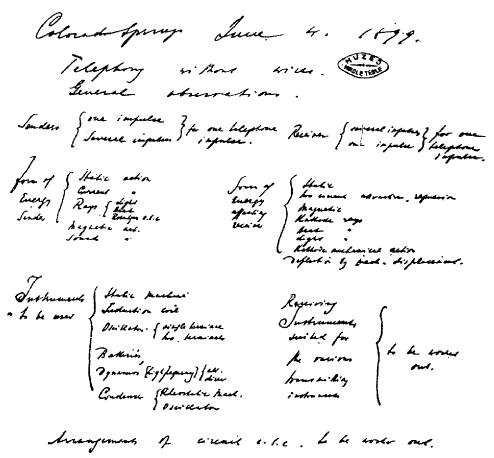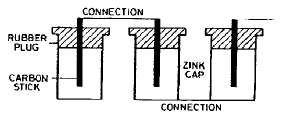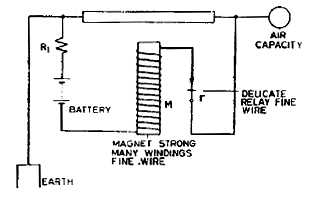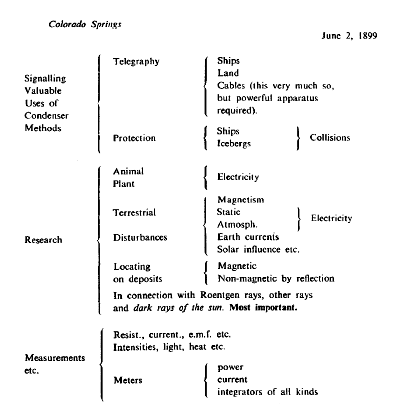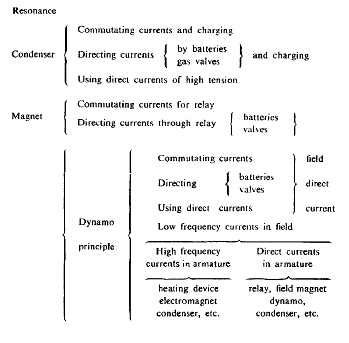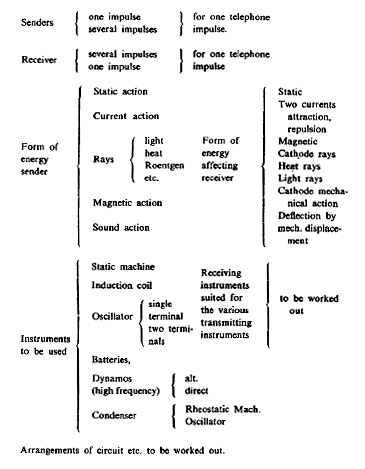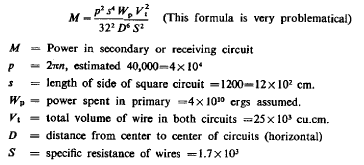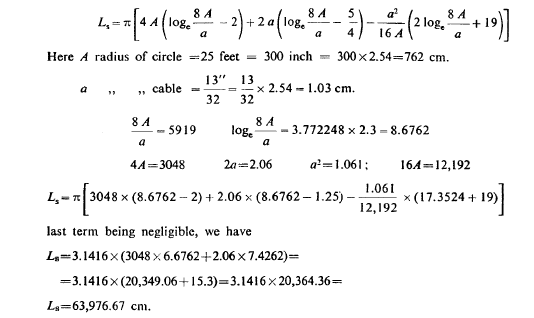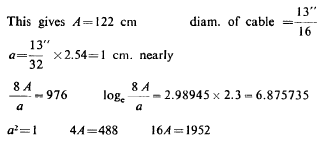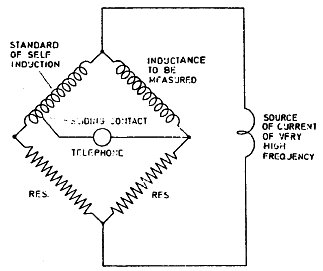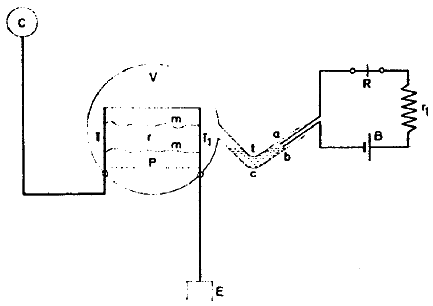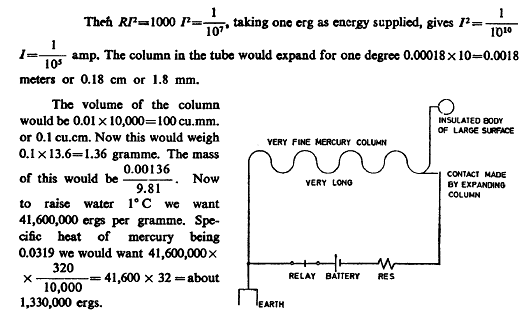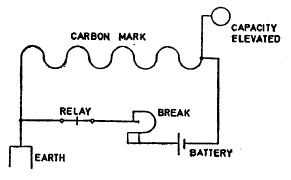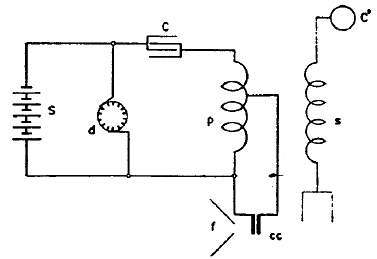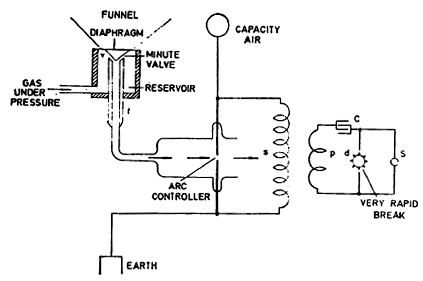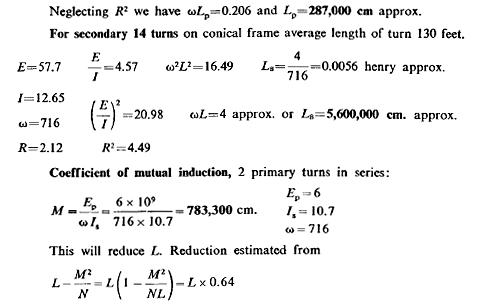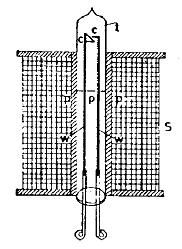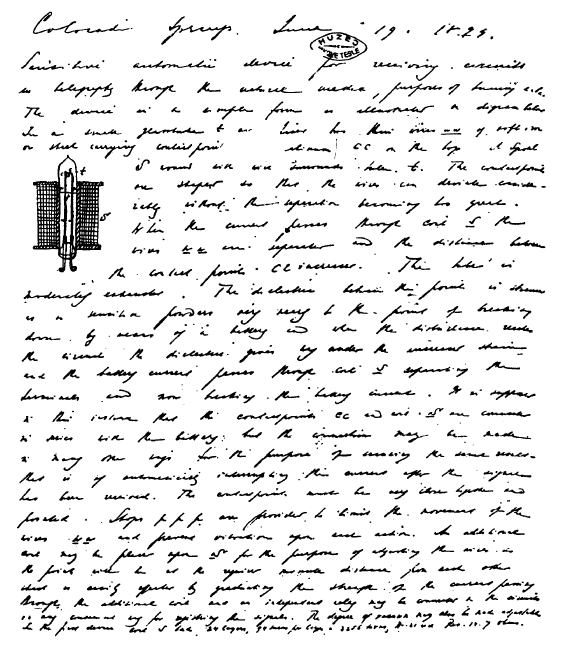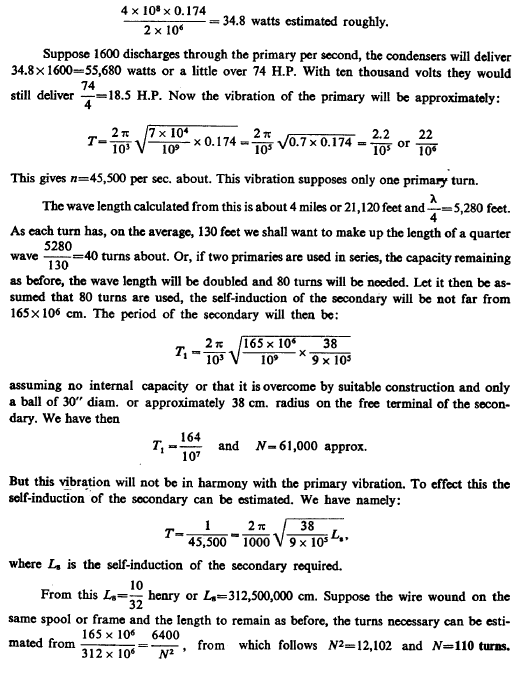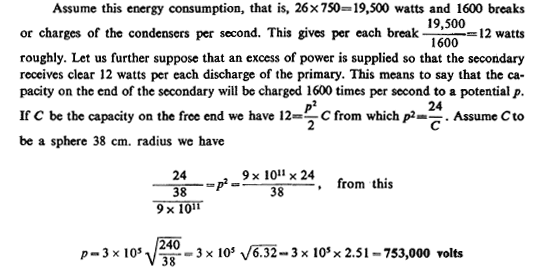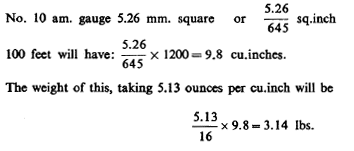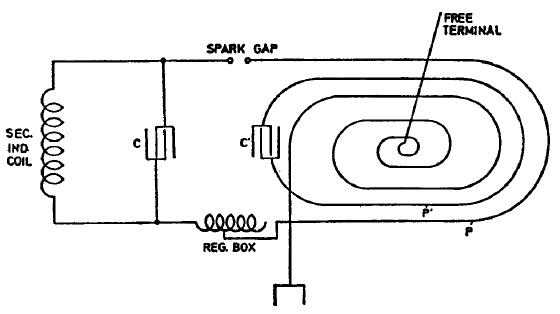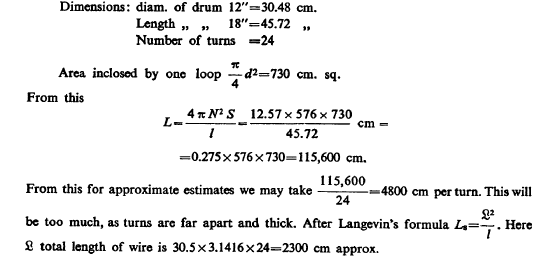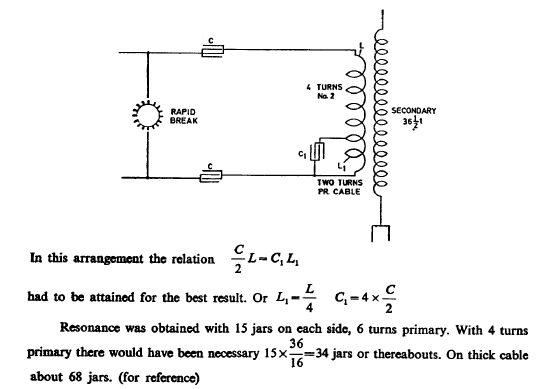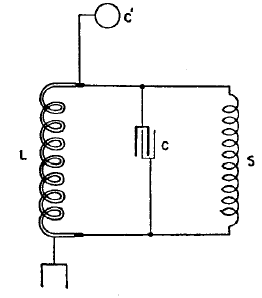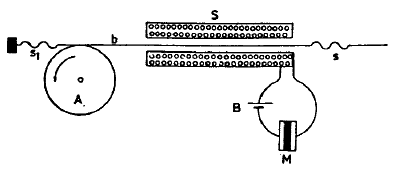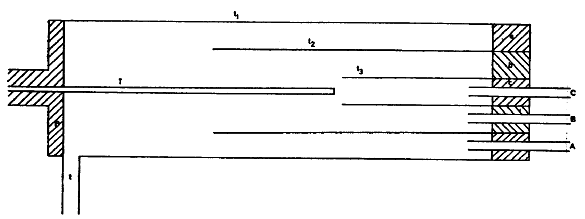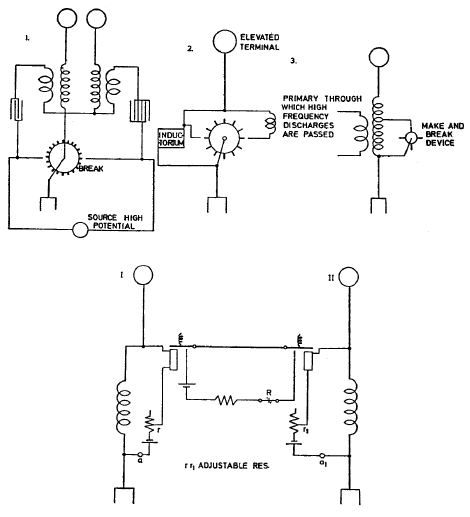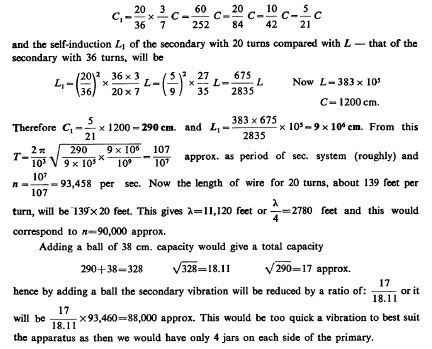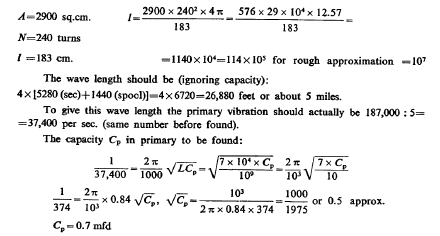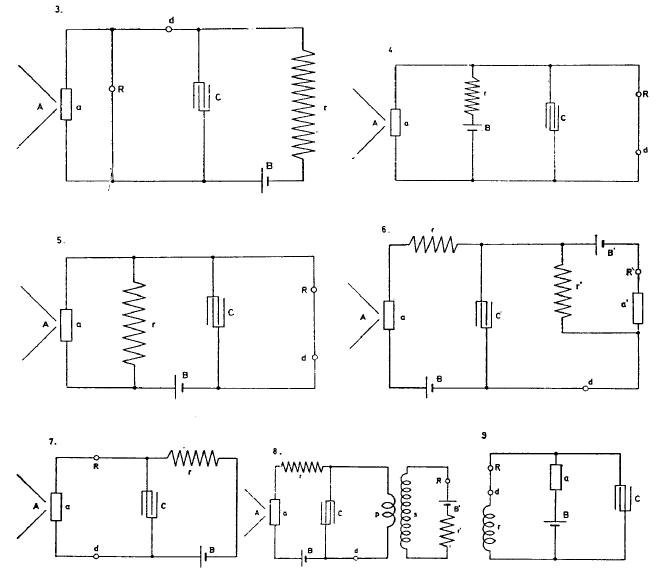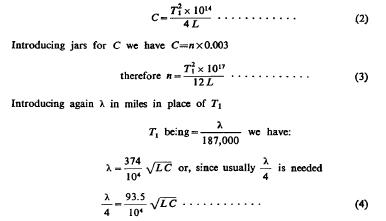|
As the current for exciting the tube need be only very small the battery can furnish a minute current. From previous experiments about 1/20,000 amp. is amply sufficient. Approximate dimensions of box 1/4 cu. foot. The price will not be prohibitory. Tin caps, plugs and carbons will be readily obtainable.
The connection of the receiver is to be as in experiments in New York: If necessary the resistance 7?j will be used to strain the tube exactly just to point of breaking down. It is very important as in all sensitive devices so far used that the dielectric is strained exactly to the breaking point.
The magnet M is to have a resistance nearly equal to the internal resistance of the battery, so as to get best output. The relay will suit as it is with 1000 ohms resistance. The magnet must be strong to blow out tube when lighted. This device should by very sensitive and should break down by very minute currents propagated through the earth from a similarly connected oscillator.
Colorado Springs
Telephony without wires. General observations: one impulse for one telephone
Taking M to be the minimum 0.3 ergs to affect relay, it is found
that with above circuits and under such conditions about 1 mile
communications should be possible. With circuits 1000 meters square,
about 30 miles. From this, the inferiority of the induction method
would appear immense as compared with disturbed charge of ground and
air method.
Immersion in oil is inconvenient, likewise other expedients of this kind. The best results will probably be obtained in the end by static screening of the vulnerable parts of the tube. This idea was experimented upon in a number of ways. It is now proposed to test the arrangements indicated below:
In each case there would be an insulated body of capacity so
arranged that the streamers can not manifest themselves. The
capacity would be such as to bring about maximum rise of e.m.f. on
the free terminal.
or
approx: 63,900 cm.
this is a trifle more
with ends close enough 8,000 cm.
A standard of self-induction is provided with a sliding contact so that any number of turns can be inserted. Two resistances, suitable for the source of high frequency current and the inductance to be measured, are connected in the manner of a bridge. The two opposite points, one movable, are connected through a telephone. When no sound is heard then we have the two inductances that is, the one to be measured, and that part of the standard which corresponds to equilibrium or silence in the telephone-practically equal if the quantities are suitably chosen.
By determining inductances
capacities may from these be easily measured. It is possible that
the high frequency source might be dispensed with and a very sudden
discharge of a condenser passed through instead. The auxiliary
resistance should be so determined that the resistances in the two
parts through which the current divides are equal or nearly so.
This resistance may be conveniently
obtained by connecting with pencil marks m m two terminals T and T1,
holding a glass plate P. The mass must be minute so that the smallest amount of current would raise the
temperature of the marks or conductors and thus heat the air in the
reservoir which, expanding, would
drive a minute column of liquid c
contained in tube t towards contacts a b. The liquid should be very
E light and need not be highly conducting, barely enough to allow the
The
resistance r, may be used to regulate battery strength. The
terminals T T1, I would preferably connect in the manner I generally
resort to, that is, one to the ground and the other to a body of
some surface and elevated. Suppose air is used, we would want 0.1696
Ca per ฐC per gramme. It will be now easy to calculate how much the
air can be expanded per erg of energy supplied.
Suppose the tube were 1/10 mm. diam. and 10 meters long; its resistance would be approx.
This shows that on the above assumptions, indication of disturbances
by mercury column would be hardly practicable unless the column
could be made much thinner.
The general idea is to provide a path for the passage of a current such that it will diminish in resistance when the current passes and also such that it will be of as minute a mass as possible. The specific heat of the material forming the path for the current should also be as small as possible. The best way I have so far found is to make a mark of the required thickness with a carbonstick so as to connect two terminals through a conductor of high resistance so deposited.
This conductor I preferably connect with one end to the earth and with the other to an elevated object of a large surface. The conductor is further connected in circuit with relays and batteries in any way suitable, as for instance in the arrangement here shown. Now when a feeble impulse passes it reduces the resistance of the carbon and more of the battery current can pass through and so on until the relay is brought into action.
The relay
then, in any way suitable, breaks the current of the battery and a
normal regime is established. The relay itself may be utilized to
break the current or an auxiliary magnet may be employed as
illustrated. The carbon mark may be connected in the manner of a
bridge to increase sensitiveness.
S is a source of preferably direct current as a powerful battery or
dynamo, C a condenser which is connected with a primary p and break
d as usual in an oscillator. The break d is such that at the number
of breaks resonance is obtained.
Normally
these carbons touch loosely but by speaking upon funnel / they are
harmonically pressed together and the primary current is diverted
thus destroying the resonance and greatly diminishing effect in the
secondary rhythmically with the undulations of the voice. In this
manner very minute variations in the contact resistance are made to
produce great variations in the intensity of the waves sent out. The
breaks at d must be much above undulations of the voice.
The idea is to use an ordinary oscillator, preferably one operated from a source of direct currents with a break (mercury or simply an air gap) which is much higher infrequency than the vibrations of the voice. At any rate, there will be an arc, whether in the primary of the secondary which will be blown out, or the resistance of which will be enormously increased, rhythmically with the vibrations impressed by voice or otherwise, as the case may be.
The control of the arc is effected by a jet of air or other gas issuing under pressure from an orifice the opening of which is controlled in some convenient way by the vibrations. An arrangement of such apparatus is illustrated in the diagram below, the arc controlled thus being in the secondary. The source of direct currents S charges a condenser C and the discharges of the same (a very great number) through a break d and primary p energize a secondary s with the usual connection in telegraphy as I have introduced.
The air or gas under pressure is controlled by a
diaphragm and valve v. The outlet pipe / can be screwed up as close
to the diaphragm as is necessary for the best result In this or a
modified way a powerful apparatus may be controlled by very feeble
undulations, as those of the human voice.
By keeping the water constantly running the resistance
was finally reduced to 14 ohms between the earth plate and the water
main. By connecting the earth plate and water main again, the lower
end of the secondary being connected to the latter, sparks would
again fly over the arresters. When the water main was disconnected
they again ceased.
It responded also all
along a water main, as far as it reached, although it was connected
to the ground fairly well. The action on the device was still strong
when there were no sparks from the secondary terminal. This is a
good indication for the investigation of waves, stationary in the
ground. It was concluded the earth resistance was still too great.
Possibly the ground affects the primary and the secondary, more than
assumed, by the formation of induced currents.
The first good
ground was evidently at the point where the water main feeding the
laboratory connected to the big main underground and this was
several hundreds of feet away. This introduced additional length in
the secondary wire which became thus too long for the quarter of the
wave as calculated. The nearest connection to earth was as measured
about 260 feet away and even this one was doubtful.
Colorado Springs
The trouble seems to be due to
internal capacity. The total length of a quarter wave with coil was
about 2400 feet, which agrees fairly with the calculation from the
vibration of the primary circuit. The experiments with the coil show
strikingly the advantage of an extra coil, as I call it, already
noticed in experiments in New York; that is, a coil practically not
inductively connected but merely used to raise the impressed
electromotive force.
Compared with the first winding (14 turns far apart) the second
winding was better because of both higher self-induction and greater
mutual induction coefficient.
In a small glass tube / are fixed two thin wires w w of soft iron or steel carrying contact points of platinum c c on the top. A spool S wound with wire surrounds tube. The contact points are shaped so that the wires can deviate considerably without the separation becoming too great. When the current passes through coil S the wires w w are separated and the distance between the contact points, c c increased. The tube is moderately exhausted.
The dielectric between the points is strained, as in sensitive powders, very nearly to the point of breaking down by means of a battery and when the disturbance reaches the circuit the dielectric gives way under the increased strain and the battery current passes through coil S separating the terminals and now breaking the battery current. It is supposed in this instance that the contact points cc and coil S are connected in series with the battery, but the connection may be made in many other ways for the purpose of securing the same result that is of automatically interrupting the current after the signal has been received.
The contact points must be very close together and pointed. Stops ppp are provided to limit the movement of the wires w w and prevent vibration upon each action. An additional coil may be placed upon S for the purpose of adjusting the wires so the points will be at the required minute distance from each other, which is easily effected by graduating the strength of the current passing through the additional coil and an independent relay may be connected in the circuits in any convenient way for registering the signals. The degree of vacuum may also be made adjustable. In the first device coil S had 24 layers, 94 turns per layer=2256 turns, No. 21 wire, res. 14.7 ohms.
Colorado Springs
In addition to the wire already on hand this would cost about $ 250 but with 80 turns only $ 100 will be necessary. To keep the vibration of the secondary the same,-the capacity on the free terminal will have to be increased. The capacity necessary will be C and we have:
All these estimates assume, of course, that the distributed capacity
of the secondary is overcome in some way or other as by condensers
in series, for instance. It is quite certain that the vibration of
the secondary will be much slower.
Approximate estimate of primary voltage necessary for above output.
With this e.m.f. assume 4 ohms res. of arc, the initial current
would be 1500 amp. through the primary. From these assumptions the
loss in the primary may be computed.
Accordingly, 11,000 feet will weigh 345.4 lbs. This will give still
less copper in the secondary than there is in the two primary turns.
With secondary wire double we shall have 40 turns and with four
wires (for quick vibration) 20 turns. The weight of copper should be
equal and some of the No. 10 cord may be used on the first low
turns.
The condenser C1 was placed in shunt to the primary P. Since there
was no spark gap in this circuit and the magnifying factor was very
large, the resistance being minute, the vibration continued much
longer after each break as would be the case with the ordinary
connection. A very curious feature was the sharpness of tuning. This
seems to be due to the fact that there are two circuits or two
separate vibrations which must accord exactly. The sparks were
strong on terminals of the secondary always when C=a C1, a being a
whole number (no fraction), and particularly when a2 or 4.
This plan was also experimented with in New York and
it was found that it is good when the break number is very small.
When the break is very rapid there is not much difference. In making
the adjustments C'P' was first tuned to the vibration of CP, then
the secondary was adjusted.
Experiments with oscillator secondary 36 1 /2 turns were continued. Many modified arrangements with auxiliary condensers one of which is illustrated in the sketch below were tried. All these chiefly aimed at prolonging the vibrations in the primary after each break and also at effecting sharper tuning of the circuits.
In using auxiliary condensers in this way circuits are obtained containing no spark gap in which the damping factor was extremely small and the magnifying factor very great.
Note: Several rates of vibration were tried with such arrangements.
Remarkable was the sharp tuning in some of them, one turn of the
regulating coil being sufficient to entirely de troy the effect or
to produce a great maximum rise of pressure. The jars broke down
frequently, owing to sudden rise, as the handle of the regulating
coil was turned.
The following plan of producing a conducting path of extremely low resistance suitable for resonating circuits and other uses offers the possibility of attaining results which can not be reached otherwise. It is based on my observation that by passing through a rarefied gas a discharge of sufficient intensity, preferably one of high frequency, the resistance of the gas may be so diminished that it falls far below that of the best conductors.
So through just a bulb of highly rarefied gas an immense amount of energy may be passed and currents of a maximum strength such that they can not traverse a copper wire, owing to its resistance and impedance, may be made to traverse the rarefied gas.
The plan now is to constitute a circuit composed of a rarefied gas column, heated by auxiliary means to a very high incandescence so as to offer an inconceivably small resistance to the passage of the current and use this column for the purpose to which it is suited. To illustrate the use of this idea in telegraphy, for instance the diagram below is shown in which S is a source of oscillating currents of preferably high frequency, C a condenser in shunt to same, L a coiled glass tube containing the rarefied gas which is kept at a high degree of excitation.
The conductor L is connected, as in my system, to earth
and a capacity preferably elevated. Through this path the currents of a distant transmitter are made to pass
which are of the same frequency and cause a great rise of the e.m.f.
on the terminals of conductor L, which may then be utilized to
affect a receiving instrument in many ways.
A spring may be used to pull the brush back against the friction and to maintain it in a position of delicate equilibrium. Let now the brush or surface be but slightly magnetized, then the friction between the magnetic surfaces will be enormously increased and the brush will be pulled forward with great force.
A small variation in the magnetization of the surface will thus make great changes in the force exerted upon the brush, and the movements of the latter may be utilized for any purpose, as for instance in loud speaking telephones, or in perfecting a "wireless telephone" or such purposes.
A simple form of apparatus is
illustrated below: A is a rapidly rotating cylinder with a polished iron surface, if not
all of iron; b is a small bar or brush bearing upon the cylinder and
also of soft iron. This light plate or bar is held in a balanced
position by differential spring sst so as to bear lightly on the
cylinder A. S is a solenoid energized through battery B in series
with a microphone M. By speaking upon the latter the bar b will be
vibrated back and forth and the movements of the bar may control any
other apparatus, for instance a valve or other microphone.
Note: in this apparatus it will be preferable to use a form of
oscillator with mercury break supplied from a source of direct
current, so that the force on T will be mostly uni-directional.
Any other generator developing the necessary e.m.f. should, however,
accomplish the same result.
The high tension terminal T is led in through an
insulating plug P fastened into the largest tube t1. The particles
of the gas coming in contact with the active terminal are thrown
away with great force and are projected at different distances
according to their size and weight, hydrogen farther then most
others. The latter element, if it be present, will therefore pass
through tube A, that is mostly, the heavier and larger
Experiments have shown that a great degree of safety is reached with two circuits. I think with three it is almost impossible to disturb the receiver when the vibrations have no common harmonics very near to the fundamental tones. Several arrangements experimented with are illustrated below. These are to be followed up.
Figs. 1., 2. and 3. illustrate some arrangements of apparatus on the sending station by means of which two vibrations of different pitch are obtained. A greater number is omitted for the sake of simplicity. In case 1. are provided two sending circuits which should be some distance apart and which are energized alternately by discharging condensers of suitable capacity through the corresponding primaries.
In Figures 2. and 3. one sending circuit is arranged so that its period is altered by inserting some inductance as in 2., or by short-circuiting a part of the circuit periodically, by means of an automatic device. It is not necessary to use such a device; however, arrangements of this kind will be later illustrated. On the receiving station two synchronized circuits responding to the vibrations each to one of the sender. The receiver R responds only when both circuits I and II affect sensitive devices a a.
The diagrams are self-explanatory.
With the additional coil of 1500 cm. capacity added in series with
secondary on free terminal, the capacity would be 1500+290=1790,
that is about 6 times as much as before. The vibration will then be
slower \J'6=2.5 approx. times slower, about 37,400 per sec. This
better suited.
This would require 0.7/0.003 jars=233 jars with two primary turns in multiple
and or about 58 jars total with two primaries in series. As so
many jars were not available evidently only a higher vibration was
obtainable. This explains why first results unsatisfactory.
Colorado Springs
Observations made in experiments with oscillators, 36 1/2
turns and
additional coil:
But when the impressed vibration is very large and the coil's own momentum small, the free vibration can not assert itself readily. It is exactly as in mechanics. A pendulum with great momentum relative to the impressed momentum swings rigorously through its own period but when impressed momentum is very large relatively it is hampered, for then the impressed dominates more or less. This I look upon as distinct from the magnifying factor which depends on pL/R.
It was evident that in such excitation of the additional coil there
should be, for the best result, three vibrations falling together:
that of the coil, that of the secondary and that of the combined
system. In view of the above it is of advantage to place inductance
between the secondary and additional coil to free the latter, when
impressed vibration is too powerful to allow the intended vibration
of the coil to take place readily.
|
